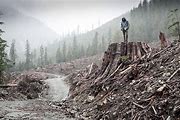Driving through the Black Hills National Forest, raindrops dance on the windshield as snowflakes gently swirl in late April. This picturesque scene unfolds amidst a backdrop of climate change-induced drought that has plagued the region. The forest’s grandeur is evident along major roads, where ancient “yellowbarks
” stand tall, reminiscent of cathedral pillars. These majestic trees, deemed crucial for “
scenic integrity
” by the Forest Service, have long been a subject of contention—critics dub them a mere “
green screen.
”
Venture off the beaten path into side roads, and you’ll encounter vast swathes of land scarred by commercial logging activities. Whitetail deer roam freely across what now resembles more of a tree-dotted field than a thriving forest. Invasive grassland species like bromegrass and knapweed creep in, threatening the delicate balance that sustains this ecosystem.
Ponderosa pines dominate these lands, with their seeds reaching peak viability after 60 years—a fact that underscores the irreversible impact of overcutting coupled with the looming specter of climate change. Recent decades have seen the Black Hills endure significant challenges such as historic beetle infestations and massive wildfires—all exacerbated by a changing climate.
However, new threats loom large as governmental directives pave the way for intensified logging activities in nearly 60% of the Black Hills. While wildfire risk mitigation serves as one justification for these actions, environmental advocates decry this move as shortsighted and damaging to both biodiversity and carbon sequestration efforts.
“
It’s absolutely, completely a U-turn,
” remarked Taylor Gunhammer from NDN Collective—an Indigenous rights nonprofit rooted in the Black Hills—highlighting how these directives contradict previous agreements aimed at sustainable forest management in collaboration with tribal nations.
The timber industry applauds these developments despite dwindling prospects for substantial timber yields due to depleted resources—the legacy of centuries-old exploitation dating back to General Custer’s unlawful incursion fueled by gold fever.
Historical treaties designating Pahá Sápa (“
Black Hills”) as unceded Native land underscore longstanding injustices perpetuated against Indigenous communities—the recent push for increased logging further exacerbates these wounds.
As conservationists rally against rampant deforestation within ancestral territories, calls grow louder for returning stewardship rights to Indigenous peoples who possess traditional ecological knowledge essential for safeguarding these vital ecosystems—a paradigm shift essential for restoring ecological balance and justice on these sacred lands.
Around the globe, movements advocating for landback initiatives highlight indigenous-led conservation efforts as exemplars of sustainable co-existence between humanity and nature—a model urgently needed amidst escalating environmental crises worldwide.









Leave feedback about this